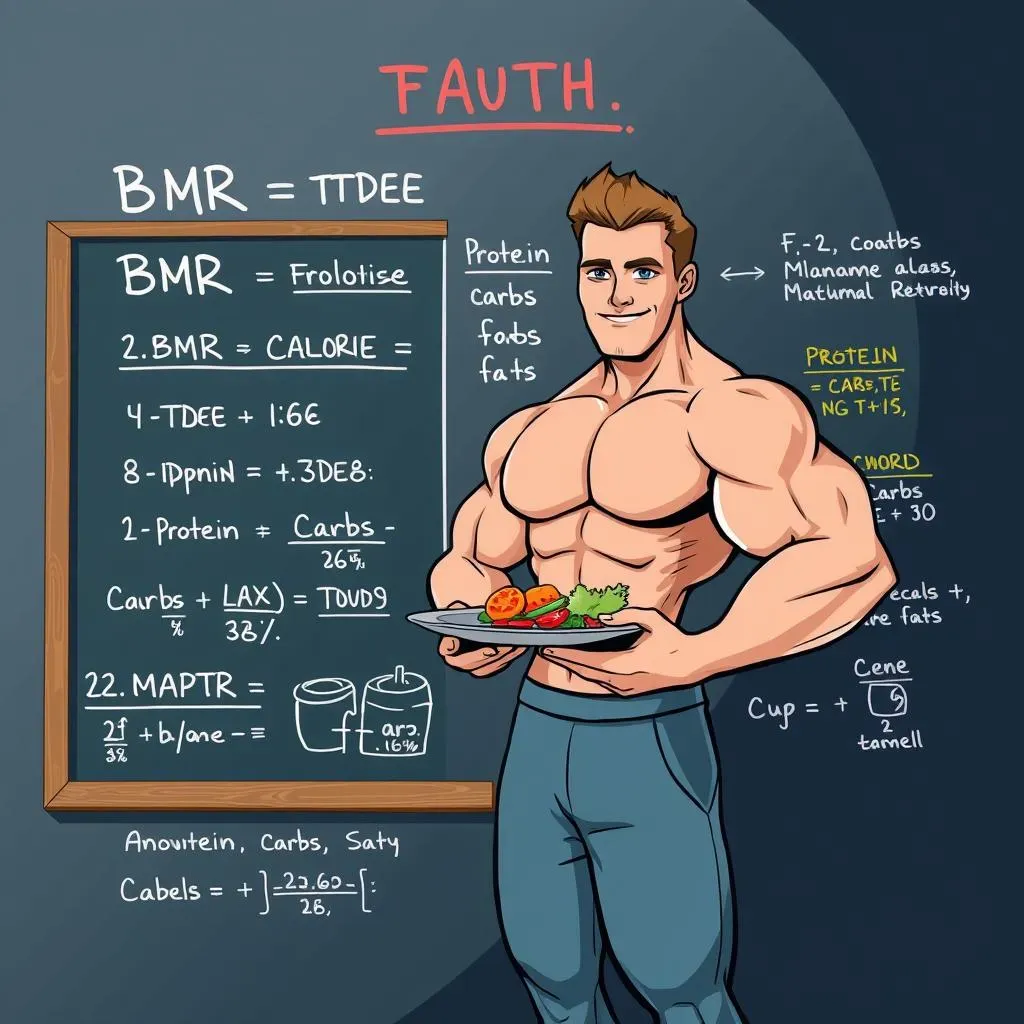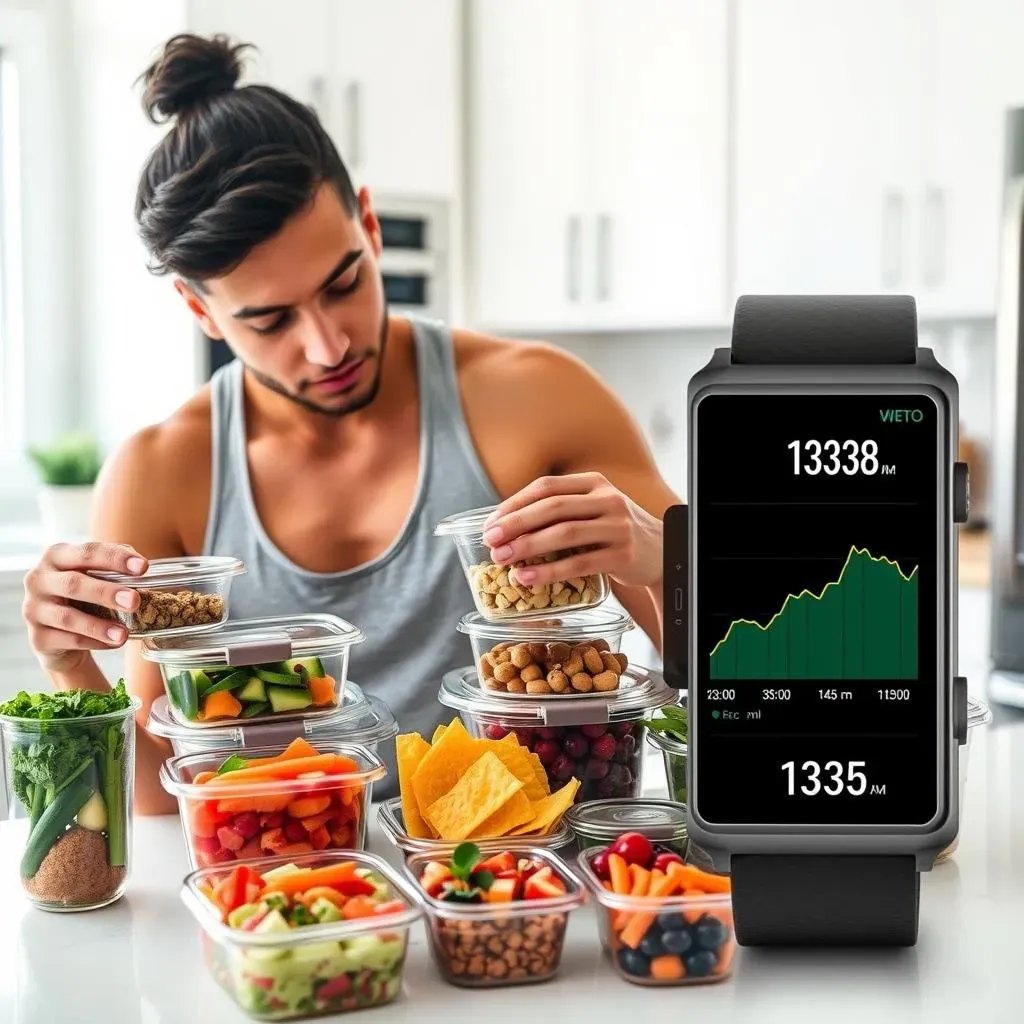Table of Contents
Trying to pack on muscle but struggling with meal planning? You're not alone. Bulking can feel like a full-time job, especially when you're trying to balance workouts, work, and a social life. That's where easy meal prep ideas for bulking come in. This isn't about spending hours in the kitchen or choking down bland, repetitive meals. It's about smart planning and simple recipes that fuel your body and make your bulking journey sustainable. Forget the guesswork and the last-minute takeout decisions.
Calculating Your Calorie and Macro Needs for Bulking

Calculating Your Calorie and Macro Needs for Bulking
Step 1: Finding Your Baseline Calories
so you want to bulk up? Awesome! But before you start piling food on your plate, let's figure out how much you actually need. This isn't about guessing; it's about science. First, you need to determine your Basal Metabolic Rate (BMR). This is the number of calories your body burns at rest, just to keep you alive. There are several online calculators that can estimate your BMR based on your age, sex, height, and weight. A popular and fairly accurate one is the Mifflin-St Jeor equation. Plug in your numbers and get ready to take the next step.
Once you have your BMR, you need to factor in your activity level. Are you a desk jockey who hits the gym three times a week, or are you on your feet all day and crushing workouts daily? Multiply your BMR by an activity factor to get your Total Daily Energy Expenditure (TDEE). Here’s a quick guide:
- Sedentary (little to no exercise): BMR x 1.2
- Lightly active (light exercise/sports 1-3 days/week): BMR x 1.375
- Moderately active (moderate exercise/sports 3-5 days/week): BMR x 1.55
- Very active (hard exercise/sports 6-7 days a week): BMR x 1.725
- Extra active (very hard exercise/sports & physical job or 2x training): BMR x 1.9
Step 2: Adding the Bulking Surplus
Alright, now you know how many calories you burn each day. To gain weight, you need to eat more than that – a calorie surplus. A good starting point is a 10-20% surplus. So, if your TDEE is 2500 calories, aim for an extra 250-500 calories per day. This puts you in the 2750-3000 calorie range. Monitor your weight and adjust accordingly. If you're not gaining weight after a week or two, bump up the surplus by another 250 calories. If you're gaining weight too quickly (more than 1-2 pounds per week), scale it back slightly.
Now, let's talk macros – protein, carbs, and fats. These are the building blocks of your diet, and getting them right is crucial for muscle growth. As a general rule of thumb, aim for:
- Protein: 1 gram per pound of body weight (or 2.2 grams per kilogram)
- Fats: 0.3-0.5 grams per pound of body weight (or 0.6-1.1 grams per kilogram)
- Carbohydrates: Fill in the remaining calories with carbs.
For example, if you weigh 180 pounds and are aiming for 3000 calories, your macro breakdown might look something like this:
- Protein: 180 grams (720 calories)
- Fats: 72 grams (648 calories)
- Carbohydrates: 393 grams (1632 calories)
Remember, these are just starting points. Experiment and find what works best for your body and your goals. Don't be afraid to adjust your macros based on how you feel and how your body is responding.
Clean Bulking vs. Dirty Bulking: Which is Right for You?

Clean Bulking vs. Dirty Bulking: Which is Right for You?
The Allure of Clean Bulking
so you've got your calorie and macro targets dialed in. Now comes the big question: how are you going to hit those numbers? This is where clean bulking and dirty bulking diverge. Clean bulking is all about prioritizing nutrient-dense, whole foods. Think lean proteins like chicken breast, fish, and Greek yogurt; complex carbs like brown rice, quinoa, and sweet potatoes; and healthy fats from avocados, nuts, and olive oil. The goal is to gain muscle while minimizing fat gain.
The idea behind clean bulking is that by focusing on quality calories, you'll optimize your body's ability to build muscle and recover from workouts. You'll also be providing your body with essential vitamins, minerals, and fiber, which are crucial for overall health. It's a slower, more controlled approach, but many believe it leads to better long-term results and a healthier physique.
The Temptation of Dirty Bulking
On the other side of the spectrum, we have dirty bulking. This approach is much less restrictive, focusing primarily on hitting your calorie surplus regardless of the food sources. Pizza, burgers, ice cream – anything goes, as long as it helps you reach your calorie goals. The appeal of dirty bulking is obvious: it's easier and more enjoyable for some people. You don't have to obsess over every single ingredient, and you can indulge in your favorite treats without guilt.
However, there's a catch. Dirty bulking typically leads to more fat gain than clean bulking. While you might see faster weight gain on the scale, a significant portion of that will be fat, not muscle. This can result in a less aesthetic physique and potentially increase your risk of health problems like high cholesterol and insulin resistance. Plus, the lack of micronutrients from processed foods can leave you feeling sluggish and impact your performance in the gym.
Making the Choice: Factors to Consider
So, which approach is right for you? There's no one-size-fits-all answer. It depends on your individual goals, genetics, and lifestyle. If you're a beginner, clean bulking is generally recommended. It's a more sustainable and healthier way to build muscle, and it sets a good foundation for long-term progress. However, if you're an experienced lifter who's struggling to gain weight, or if you simply find it too difficult to adhere to a strict diet, dirty bulking might be a viable option.
Ultimately, the best approach is the one that you can consistently stick to. Experiment with both clean and dirty bulking to see how your body responds. Pay attention to your energy levels, body composition, and overall health. And remember, consistency is key. Whether you choose to eat clean or dirty, make sure you're consistently hitting your calorie and macro targets to maximize your muscle growth.
Feature | Clean Bulking | Dirty Bulking |
|---|---|---|
Food Sources | Whole, unprocessed foods | Any foods that meet calorie goals |
Fat Gain | Minimal | Significant |
Health Benefits | Improved overall health | Potential health risks |
Sustainability | More sustainable long-term | Less sustainable long-term |
Difficulty | More difficult to adhere to | Easier to adhere to |
Easy Meal Prep Ideas for Bulking: A Week of Gains

Easy Meal Prep Ideas for Bulking: A Week of Gains
Alright, let's get to the good stuff: actual meal prep ideas! This is where the rubber meets the road. We're going to map out a sample week of bulking meals, focusing on hitting those calorie and macro targets we discussed earlier. Remember, these are just suggestions – feel free to swap out meals and ingredients based on your preferences and dietary needs. The goal is to give you a framework to build your own easy meal prep ideas for bulking routine.
We'll aim for three main meals and two snacks per day, all designed to be prepped in advance and easily portable. We're talking about maximizing your time and minimizing the chances of skipping meals or resorting to unhealthy options when you're short on time. Think about it: no more excuses for not hitting your calorie goals! Each meal will be balanced with protein, carbs, and fats to support muscle growth and recovery. So, grab your containers and let's dive in!
- Meal 1: Overnight Oats with Protein Powder and Berries
- Meal 2: Chicken and Brown Rice Bowl with Roasted Vegetables
- Meal 3: Greek Yogurt with Granola and Almonds
Day 1: Monday - Kickstarting the Week
Breakfast: Overnight Oats with Protein Powder and Berries. Combine ½ cup rolled oats, 1 scoop protein powder, 1 cup milk (dairy or non-dairy), and ½ cup mixed berries in a jar. Let it sit in the fridge overnight. Boom, breakfast is served!
Snack 1: Apple slices with 2 tablespoons of peanut butter. Simple, satisfying, and packed with healthy fats and fiber.
Lunch: Chicken and Brown Rice Bowl with Roasted Vegetables. Grill or bake 4-6oz chicken breast and pair it with 1 cup cooked brown rice and 1 cup of roasted vegetables (broccoli, carrots, bell peppers). Season with your favorite herbs and spices.
Snack 2: Protein shake with 1 scoop protein powder, 1 banana, and 1 cup milk. A quick and easy way to boost your protein intake.
Dinner: Lean Ground Beef Stir-Fry with Noodles and Vegetables. Brown 4-6oz lean ground beef and stir-fry it with 1 cup cooked noodles and 1 cup mixed vegetables (broccoli, snap peas, carrots). Season with soy sauce and ginger.
Day 2: Tuesday - Keeping the Momentum Going
Breakfast: Scrambled Eggs with Whole Wheat Toast and Avocado. Scramble 3-4 eggs and serve them with 2 slices of whole wheat toast and ¼ avocado. A great source of protein and healthy fats.
Snack 1: Handful of almonds (about ¼ cup).
Lunch: Turkey and Quinoa Salad. Combine 4-6oz sliced turkey breast with 1 cup cooked quinoa, ½ cup chopped vegetables (cucumber, tomato, bell pepper), and a light vinaigrette dressing.
Snack 2: Cottage cheese (1 cup) with pineapple chunks.
Dinner: Baked Salmon with Sweet Potato and Asparagus. Bake 4-6oz salmon fillet and serve it with 1 medium sweet potato and 1 cup steamed asparagus. Season with lemon and herbs.
Day 3: Wednesday - Halfway There!
Breakfast: Greek Yogurt with Granola and Almonds. Combine 1 cup Greek yogurt with ¼ cup granola and ¼ cup almonds. A quick and easy way to boost your protein intake.
Snack 1: Rice cakes (2) with avocado and everything bagel seasoning.
Lunch: Leftover Baked Salmon with Sweet Potato and Asparagus.
Snack 2: Hard-boiled eggs (2).
Dinner: Chicken Breast with Roasted Brussels Sprouts and Mashed Potatoes. Bake 4-6oz chicken breast and serve it with 1 cup roasted Brussels sprouts and 1 cup mashed potatoes.
Day 4: Thursday - Almost to the Weekend
Breakfast: Protein Pancakes. Mix protein powder with oats and egg whites for a protein-packed pancake breakfast.
Snack 1: Banana with peanut butter.
Lunch: Leftover Chicken Breast with Roasted Brussels Sprouts and Mashed Potatoes.
Snack 2: Small handful of trail mix.
Dinner: Steak with Quinoa and Green Beans. Grill or pan-sear 4-6oz steak and serve it with 1 cup cooked quinoa and 1 cup steamed green beans.
Day 5: Friday - Celebrate with Flavor
Breakfast: Smoothie with spinach, protein powder, banana, and almond milk.
Snack 1: Apple slices with cheese.
Lunch: Leftover Steak with Quinoa and Green Beans.
Snack 2: Greek yogurt with honey.
Dinner: Homemade Pizza with whole wheat crust, lean protein, and lots of vegetables.
Day | Breakfast | Snack 1 | Lunch | Snack 2 | Dinner |
|---|---|---|---|---|---|
Monday | Overnight Oats | Apple & PB | Chicken & Rice Bowl | Protein Shake | Ground Beef Stir-Fry |
Tuesday | Scrambled Eggs | Almonds | Turkey & Quinoa Salad | Cottage Cheese | Baked Salmon |
Wednesday | Greek Yogurt | Rice Cakes & Avocado | Leftover Salmon | Hard-boiled Eggs | Chicken & Veggies |
This sample meal plan provides a solid foundation for easy meal prep ideas for bulking. Remember to adjust portion sizes based on your individual calorie and macro needs. And don't be afraid to get creative with your recipes and ingredients. The key is to find meals that you enjoy and that fit into your lifestyle. Happy prepping!
Adjusting Your Meal Prep for Optimal Bulking Results

Adjusting Your Meal Prep for Optimal Bulking Results
Tracking Progress and Making Tweaks
So, you've been meal prepping like a champ and hitting your calorie and macro targets consistently. That's awesome! But bulking isn't a set-it-and-forget-it kind of thing. Your body is constantly changing, and your meal prep needs to adapt along with it. The key is to track your progress and make adjustments as needed.
Start by monitoring your weight on a weekly basis. Are you gaining weight at a reasonable rate (around 0.5-1 pound per week)? If not, you might need to increase your calorie intake. Also, pay attention to your body composition. Are you gaining mostly muscle, or are you noticing an increase in body fat? If you're gaining too much fat, you might need to adjust your macro ratios or switch to a cleaner bulking approach. Don't be afraid to experiment and fine-tune your meal prep plan until you find what works best for you.
Listening to Your Body and Avoiding Plateaus
Beyond the numbers, it's crucial to listen to your body. Are you feeling energized and recovered after your workouts? Or are you constantly tired and sore? Your body is a great indicator of whether your nutrition is on point. If you're feeling sluggish, you might need to increase your carb intake or add more micronutrient-rich foods to your diet. Similarly, if you're experiencing digestive issues, you might need to adjust your fiber intake or experiment with different food sources.
Another common challenge during bulking is hitting a plateau. You might find that your weight gain stalls, even though you're still following your meal prep plan. This is often a sign that your body has adapted to your current calorie intake. To overcome a plateau, you can try increasing your calorie surplus by another 250-500 calories per day. You can also try cycling your calories, eating more on training days and less on rest days. The key is to keep your body guessing and avoid getting stuck in a rut.
Factor | Possible Adjustment | Reasoning |
|---|---|---|
Slow Weight Gain | Increase Calories | Body needs more fuel to build muscle. |
Excess Fat Gain | Adjust Macros, Eat Cleaner | Reduce fat intake, focus on whole foods. |
Low Energy | Increase Carbs, Micronutrients | Fuel workouts, support overall health. |
Plateau | Increase Calories, Cycle Calories | Break through adaptation, stimulate growth. |
Conclusion: Your Bulking Journey, Simplified
Mastering easy meal prep for bulking isn't just about convenience; it's about consistency and control. By taking the time to plan your meals, calculate your macros, and experiment with different recipes, you're setting yourself up for success. Remember, bulking is a marathon, not a sprint. There will be times when you need to adjust your approach, whether it's tweaking your macros or finding new meal prep ideas to keep things interesting. Stay patient, stay dedicated, and most importantly, listen to your body. With the right meal prep strategy, you can achieve your bulking goals and build the physique you've always wanted.